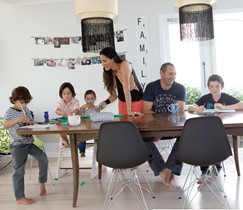A warm & dry home is a healthy home

A warm, dry home is a healthy home, with fewer days off, trips to the doctor or winter-time misery.
We breed 'em tough in Godzone. When the temperature gauge drops below 8ºC we think it might be time to put on a cardie. And as for the kids, condensation on the windows is just another opportunity to draw smiley faces.
But health experts are now saying this pioneering attitude has got to go if we want to keep our children and ourselves healthy. It's well documented that people living in cold, damp houses get sick more often than those living in warm, dry homes, and their colds, coughs and sniffles last longer.
And for New Zealand, that's most of us, as one million of the 1.6 million homes here are classed as "poor-performing", which means they're cold and probably damp.
For the one in four children suffering asthma, these houses are extra bad news, as the mould and dust mites that live in them can be triggers for asthmatic attacks.
It's time to re-organise our priorities, New Zealand, says Dr Robyn Phipps, Associate Professor in building technology at Massey University. She says, if you have $5000 to spend on a new TV and home entertainment system, why not spend it on insulation and adequate heating instead? Sure, it's not going to keep the kids amused but it will very likely keep them healthier and happier in winter.
As the healthy homes issue gains momentum nationwide, there are more Government or not-for-profit services to help you make improvements. The Government's EECA subsidy is still available, offering subsidies of 33% to 60% for home insulation and heating projects.
Auckland Council has eco design advisers who offer free advice and now there's Homestar, a national body which offers an online assessment tool and at-home consultations to look at the condition of your home and help make improvements.
How to make your home warm and dry
There's a descending scale of priorities when it comes to home improvements. But before you do anything else, ensure you have no LPG heaters in the home. Banned in many other countries, they emit one and a half litres of water vapour every hour!
Here are the top five fixes:
1. Extraction Fans. Install extraction fans in the kitchen and bathroom to remove the two main sources of moisture. This is an easy win, says Matthew Cutler-Welsh, technical manager for Homestar. Extraction fans will cost you a few hundred dollars, rather than the thousands you might spend on insulation. "And they cut out a significant amount of water vapour."
It is possible to install extraction fans in windows and this could well be the cheapest and easiest option.
Try to open the windows first thing in the morning - this is a no-cost way of letting out moist air and bringing in fresher, drier air from outside - even in humid Auckland.
2. Insulation: top, bottom and all around. It's all about creating a "thermal envelope" between the inside and outside surfaces of your home, says Matthew. You can lose up to 50% of your heating through the ceiling so this might be the most effective form of insulation in the home. If you're renovating and fancy recessed lights in the ceiling make sure installing them will not involve cutting holes in the insulation, as this will seriously compromise the effectiveness of the insulation material. In many homes moisture can seep through the floor boards, so under-floor insulation can make a great difference on a cold morning.
Insulation in the walls is probably the most expensive and difficult task as it will involve stripping off the internal cladding, insulating, re-gibbing and painting throughout the house. Most people choose to do it when they renovate, doing one room at a time.
Dr Phipps, who recently refurbished her 1930s bungalow, says the actual re-gibbing and insulation of the house cost just a few thousand dollars. Since she had to re-wallpaper anyway, replacing internal walls saved her the time and effort of stripping wallpaper and gave her a better wall finish. She also re-wired her home at the same time.
3. Double glazing or retro-glazing. This can be very expensive but there is a cheaper alternative. You can achieve the same effect as basic double glazing by hanging floor-length thermal drapes with a pelmet covering the top section.
4. Heating. Heatpumps have surged in popularity since they first came on the market, offering cheaper home heating. EECA supports heatpumps and there is a $500 subsidy for installing one if you have adequate insulation. Again, the best way to make your heatpump cheaper to run is to have good insulation so the warm air doesn't immediately seep out.
5. Ventilation. Many modern, well-insulated homes with aluminium joinery are so air-tight it can cause problems, particularly if the house is brand-new.
Principal scientist for BRANZ, Malcolm Cunningham, says some owners of new homes come home after a day at work to find their windows streaming and the flooring damp. This is caused by the construction materials, for example concrete, not having properly dried out. It pays to get security catches on windows so some can be left open when the house is empty.
Along with other experts, Dr Phipps recommends getting insulation, heating and ventilation right before investing in mechanical ventilation systems such as HRV or DVS. "There's no silver bullet that will address all those issues [insulation, heating and ventilation] in the home - it's usually much more complex," she says.
What's that smell?
Some people love the smell of fresh paint but, sadly, it's not great for your health. When you're renovating or repainting inside be aware of the level of VOCs (volatile organic compounds) present in paint, finishes and varnish.
They may also be present in the glues used for plywood and particle boards. While many of these unhealthy gases are given off in the first few days and weeks, many of them are still percolating into the atmosphere several years later.
VOCs essentially cause indoor pollution, as they give off fumes that cause a range of short and long-term effects. These include ear, eye and throat irritation, respiratory problems, headaches, possible damage to the liver, kidneys and central nervous system. Plus many of the gases are said to be carcinogenic.
Fortunately there are now low-VOC paints on the market, such as the Resene Environmental Choice range.
Other things to consider if you want to reduce VOC emissions are:
- Get rid of your plastic shower curtain. As well as being a great place to grow mould, vinyl shower curtains give off a range of gases.
- If you are buying new carpet, air it for a day or two before it's laid in the house. Alternatively lay it in summer so you can keep doors and windows open to clear the air.
- Go for eco-friendly cleaners.
- Have lots of house plants as they clean the air.
Out damn spot!
What do you do if you already have patches of mould on your ceiling?
The most effective way to get rid of it entirely is to replace that section of ceiling.
Less drastically but possibly not as effectively, you could wipe the area with a chlorine solution such as Exit Mould, or make up a bleach solution using one part bleach to four parts water.
Alternatively, use a solution of hot water, white vinegar and a half teaspoon of clove oil (from the pharmacy).
Cover with a mould-resistant paint, though be aware this may not fix the problem for good.
The nasties
- Mould comes in black, brown or pink, but whatever the shade, it's a bio-hazard. It can trigger reactions in asthma sufferers and people with other respiratory conditions and allergies. For the rest of us, it will lead to more coughs, colds and snuffles. Mould spores feed on damp conditions so by making your home warm and dry you can deter mould growth.
- Dust mites live in carpets, bedding, cushions etc and thrive in humidity. They're invisible to the naked eye but can also trigger reactions in asthma and allergy sufferers.
- Cold conditions predominate in Kiwi homes during winter and often complaining about it is to risk being told to "harden up". But in fact the World Health Organisation recommends indoor temperatures of no less than 18°C in living areas and 16°C in bedrooms. The average temperature in New Zealand homes is currently 12°C.
A 2008 study conducted by Otago University Professor Philippa Howden-Chapman in the homes of children with asthma found raising the temperature in the living room by 1.1°C and in the bedroom by 0.5°C led to a reduction in asthmatic symptoms, with fewer days off school and fewer visits to the doctor and pharmacy.
About a quarter of New Zealand children suffer from asthma. So clearly, there's a need to crank up the heating in winter.
What is Homestar?
Go to www.homestar.org.nz and take the self-assessment survey to find out how your home rates in performance. Don't worry if your property achieves only a three or four out of 10 - this is the norm in New Zealand. The idea is that home-owners will make improvements and then qualify for a higher rating. They can get an independent Homestar assessor to come and do a full assessment and get the final rating officially certified. When it comes to selling or renting your property, this rating will show how healthy your house is. Homestar technical manager Matthew Cutler-Welsh says more than 9000 online surveys have been completed since the non-profit organisation began 18 months ago. The idea is also gaining traction with architects, builders and real estate agents. In a few years having a rating of six of seven could be up there with having a double garage or spa pool when it comes to selling your home.
More information
EECA Energywise: www.energywise.govt.nz
Homestar: www.homestar.org.nz
"Effects of improved home heating on asthma in community dwelling children: randomised controlled trial" (Philippa Howden-Chapman): www.bmj.com/content/337/bmj.a1411.full

AS FEATURED IN ISSUE 17 OF OHbaby! MAGAZINE. CHECK OUT OTHER ARTICLES IN THIS ISSUE BELOW

















